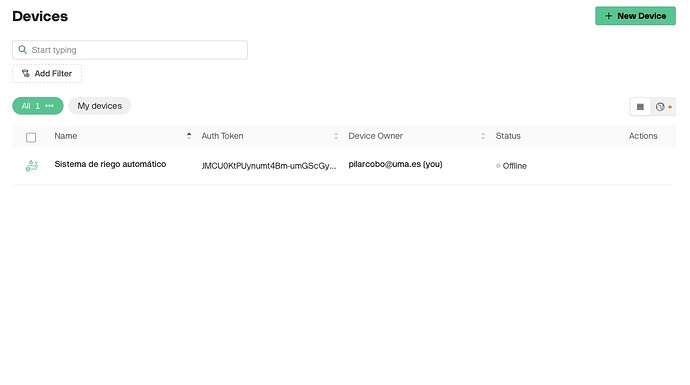Our project consists of an automatic irrigation system that includes a humidity and temperature sensor, a brightness sensor and a servo motor that simulates the action of a sprinkler that waters the plants and sends the data to our blink application via the ESP8266. There is also a display that shows the current temperature, humidity and luminosity. The sensors, display and servo work perfectly and are able to collect the data but we can’t get the device on the web to collect the data and we think it’s because it appears offline, as the ESP8266 also seems to be working fine.
// Comment this out to disable prints and save space
#define BLYNK_PRINT Serial
#define BLYNK_TEMPLATE_NAME "Sistema de riego automático"
#define BLYNK_AUTH_TOKEN "JMCU0KtPUynumt4Bm-umGScGy5oqlPxr"
// Definir pines
#define DHTPIN 2 // Pin del sensor DHT11
#define DHTTYPE DHT11
#define LDRPIN A0 // Pin del sensor de luminosidad
#define SERVOPIN 9 // Pin del servomotor
// #include <LiquidCrystal.h>
#include <DHT.h>
#include <Servo.h>
#include <SoftwareSerial.h>
#include <ESP8266_Lib.h>
#include <BlynkSimpleShieldEsp8266.h>
#include <Wire.h>
#include <LiquidCrystal_I2C.h>
// You should get Auth Token in the Blynk App.
// Go to the Project Settings (nut icon).
char auth[] = BLYNK_AUTH_TOKEN;
// Your WiFi credentials.
// Set password to "" for open networks.
char ssid[] = "Redmi";
char pass[] = "holasoyantonio";
// Inicializar pantalla LCD (sin I2C)
LiquidCrystal_I2C lcd(0x27,16,2); // set the LCD address to 0x27 for a 16 chars and 2 line display
#define EspSerial Serial1
// Your ESP8266 baud rate:
#define ESP8266_BAUD 115200
ESP8266 wifi(&EspSerial);
DHT dht(DHTPIN, DHTTYPE);
Servo aspersor;
unsigned long previousMillis = 0; // Para controlar el tiempo de espera
const long interval = 2000; // Intervalo de 2 segundos
// Umbrales de riego
const float tempThreshold = 30.0;
const float humidityThreshold = 40.0;
const int lightThreshold = 300;
// Variables para Blynk y temporizadores
BlynkTimer timer;
bool autoIrrigation = true; // Control de riego automático
void setup() {
// Debug console
Serial.begin(9600);
delay(10);
lcd.init();
lcd.begin(16, 2);
lcd.backlight();
EspSerial.println("AT+CWMODE=1");
if(EspSerial.find("OK"))
Serial.println("ESP8266 en modo Estacion");
// Set ESP8266 baud rate
EspSerial.begin(ESP8266_BAUD);
delay(10);
Blynk.begin(auth, wifi, ssid, pass, "blynk.cloud", 80);
// Iniciar el sensor DHT11 y el servomotor
dht.begin();
aspersor.attach(SERVOPIN);
aspersor.write(0); // Servomotor en posición inicial (aspersor apagado)
// Mensaje de inicialización en la pantalla LCD
lcd.setCursor(0, 0);
lcd.print("Iniciando...");
delay(2000);
lcd.clear();
// Configurar temporizadores para actualizar los sensores y la pantalla cada 2 segundos
timer.setInterval(2000L, readSensors);
}
// Función para leer los sensores y controlar el riego
void readSensors() {
// Leer datos de temperatura y humedad
float temperature = dht.readTemperature();
float humidity = dht.readHumidity();
// Leer el nivel de luminosidad
int lightLevel = analogRead(LDRPIN);
// Mostrar datos en la pantalla LCD
lcd.clear();
lcd.setCursor(0, 0);
lcd.print("T:");
lcd.print(temperature);
lcd.print("C H:");
lcd.print(humidity);
lcd.print("%");
lcd.setCursor(0, 1);
lcd.print("Luz:");
lcd.print(lightLevel);
// Enviar datos a Blynk
Blynk.virtualWrite(V0, temperature); // Enviar temperatura a Blynk (Virtual Pin V0)
Blynk.virtualWrite(V1, humidity); // Enviar humedad a Blynk (Virtual Pin V1)
Blynk.virtualWrite(V2, lightLevel); // Enviar luminosidad a Blynk (Virtual Pin V2)
// Control del riego automático
if (autoIrrigation && temperature > tempThreshold && humidity < humidityThreshold && lightLevel < lightThreshold) {
startIrrigation();
} else {
stopIrrigation();
}
}
// Función para iniciar el riego
void startIrrigation() {
aspersor.write(90); // Activar riego
lcd.setCursor(12, 1);
lcd.print("R: ON");
Blynk.virtualWrite(V3, "Riego activado"); // Notificación en Blynk
}
// Función para detener el riego
void stopIrrigation() {
aspersor.write(0); // Detener riego
lcd.setCursor(12, 1);
lcd.print("R: OFF");
Blynk.virtualWrite(V3, "Riego desactivado"); // Notificación en Blynk
}
void loop() {
Blynk.run();
timer.run(); // Ejecutar el temporizador
}
